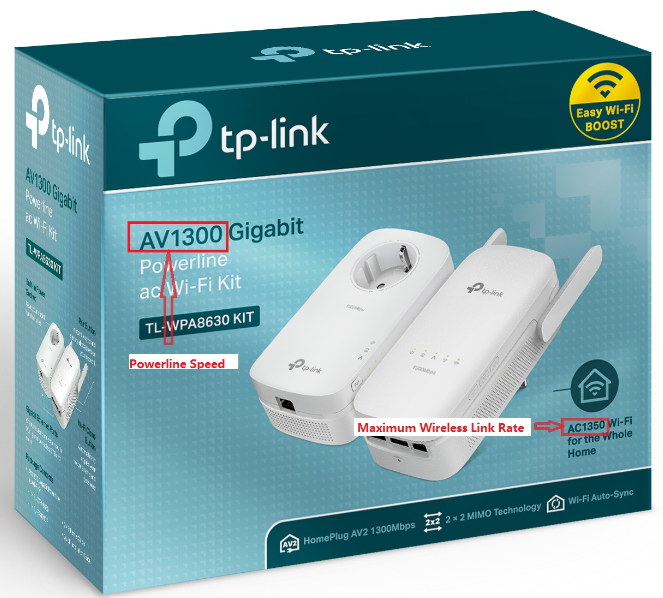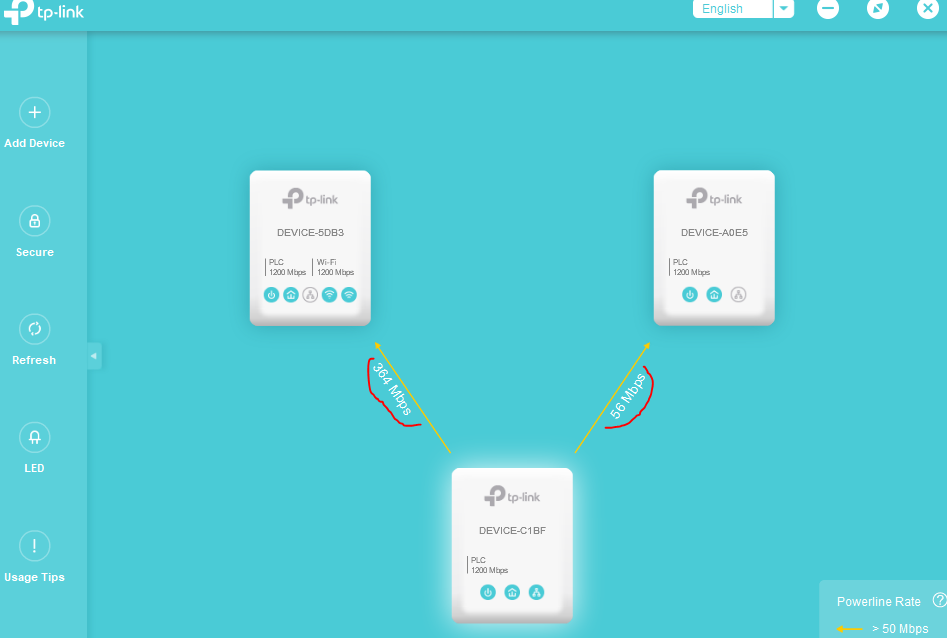Wyjaśnienie Prędkości sychronizacji i Rzeczywistej prędkości Transmiterów sieciowych
Niektórzy klienci mogą być zdezorientowani deklarowaną prędkością podaną na opakowaniu lub specyfikacją transmiterów sieciowych na oficjalnej stronie internetowej TP-Link. Deklarowana prędkość to prędkość na poziomie fizycznym, która obejmuje wszystkie dane protokołu linii energetycznej.
Weźmy TL-WPA8630KIT(TL-WPA8630 i TL-PA8010) jako przykład:

AV1300, Maksymalna prędkość synchronizacji transmiterów
AV1300 nie jest rzeczywistą prędkością, a maksymalna prędkością synchronizacji transmiterów jaka może wyświetlić się w aplikacji tpPLC. Prędkość synchronizacji transmiterów może nie osiągać 1300Mb/s w związku z występującymi zakłóceniami w środowisku ich pracy.
Poniższy przykład bazuje na środowisku z zakłóceniami. Prędkość synchronizacji transmiterów między TL-WPA8630 i dwoma TL-PA8010 wynosi tylko 364Mb/s i 56Mb/s. Jednkaże, współczynnik przeliczenia (Stosunek Predkości rzeczywistej i Prędkości synchronizacji) wynosi około 30%-35% (rzeczywisty współczynnik przeliczenia zależy od instalacji elektrycznej). W związku z tym, rzeczywista przepustowość powinna wynosić w granicach 109Mb/s-127Mb/s.

Załóżmy że prędkość synchronizacji między transmiterami TL-WPA8630 i TL-PA8010 wynosi 1000Mb/s i jest to idealne środowisko z minimalnymi zakłóceniami. W takim przypadku, realna prędkość powinna wynosić w granicach 300Mb/s - 350Mb/s. Ta reguła dotyczy praktycznie każdego produktu w standardzie Home Plug AV.
Uwaga:
- Transmitery AV600 (np. TL-WPA4010KIT) mają w idealnym środowisku maksymalną prędkość synchronizacji 600 Mb/s i powinny teoretycznie osiągać rzeczywistą prędkość na poziomie 150Mb/s - 175Mb/s, ale ta prędkość nie może przekroczyć 100Mb/s ze względu na zastosowany port Ethernet o prędkościach 10/100Mb/s. W związku z tym, jeśli prędkość synchronizacji transmiterów AV600 wynosi powyżej 200mb/s, to użytkownicy powinni osiągać rzeczywistą prędkość w granicach 100Mb/s.
- Niektóre transmitery sieciowe korzystają ze standardu HomeplugAV, jednakże są transmitery które działają w oparciu o standard HomeplugAV2 z technologią MIMO i mogą mieć niższy współczynnik przeliczenia. Na przykład, jeśli prędkość synchronizacji w aplikacji tpPLC osiąga 400Mb/s, to zgodnie ze wspomnianym przez nas współczynnikiem przeliczenia przepustowość transmiterów sieciowych HomeplugAV wyniesie około 120 Mb/s-140 Mb/s, to w przypadku transmiterów działających w standardzie HomeplugAV2 (wykorzystujących technologię MIMO) prędkość może być niższa.
AC1350, Maksymalna prędkość synchronizacji sieci bezprzewodowej
Prędkość AC1350 podana na opakowaniu jest maksymalną prędkością synchronizacji z jaką może komunikować się Twoje urządzenie z routerem (lub punktem dostępowym). Ta prędkość jest nazywana również wynegocjowaną predkością. Podane prędkości sieci bezprzewodowych to wartości maksymalne, zgodne ze specyfikacją standardu IEEE 802.11 i zależą od wielu czynników. Więcej informacji można uzyskać w tym poradniku.
Jeśli masz więcej pytań dotyczących innych kwestnii niż prędkość, sprawdź następujący poradnik dostępny tutaj.
Czy ten poradnik FAQ był pomocny?
Twoja opinia pozwoli nam udoskonalić tę stronę.
z United States?
Uzyskaj produkty, wydarzenia i usługi przeznaczone dla Twojego regionu.